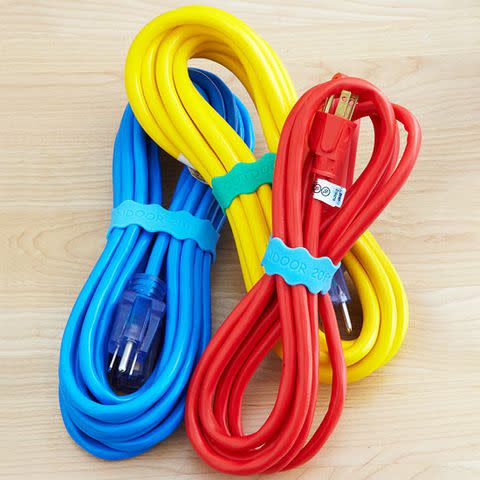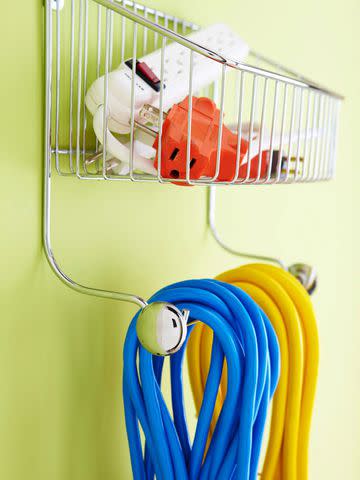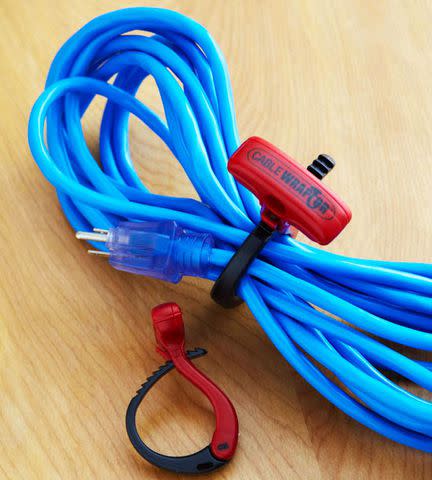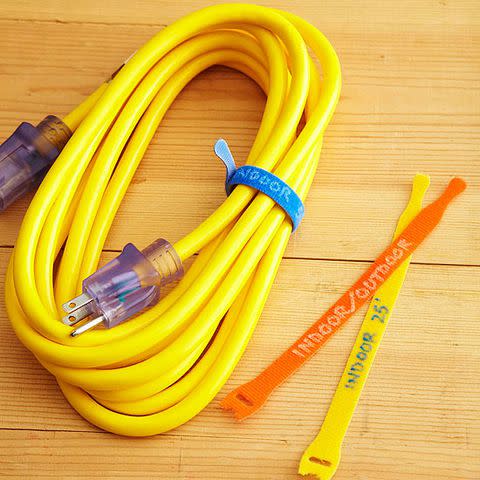How to Organize Power Cords
Corral cords and cables to keep your home clutter-free.
There’s no denying that the number of electronics we own is constantly increasing. And with those electronics come cords in all lengths, shapes, and sizes, not to mention the power cords we need to extend appliances and support outdoor power equipment. It’s important to have a system to keep cords—whether currently in use or not—organized. Our best power cord organizing hacks can help you stay sane and safe at home. Plus, you'll save time looking for the right cords, and you'll save money on unnecessary replacements.

Adam Albright
1. Bottle Them Up
If your little ones have moved on from them, repurpose the bands used to slip around baby bottles or sippy cups. Bundle medium-sized cords and cinch them with these stretchable bands. If you don’t own any, you can easily find inexpensive options online. They can be customized with any text, including information about cord length and usage, so you don't have to unravel one to check whether it's the right cord.
2. Keep in Boxes
Whether in your home office, living room, or even the bedroom, it’s important to conceal cords as much as possible to avoid a chaotic environment. A cable management box hides a bulky power strip and minimizes the look of multiple plugs. Stick one under your desk or near the TV stand and watch visual clutter disappear.

Adam Albright
3. Utilize Blank Wall Space
Loop extension cords onto a wall-mounted rack or towel bar in the basement, garage, or shed. This comes in handy when you need them for occasional home projects as they won’t take up too much space on a shelf or, worse, the floor. Hang a basket above the rack to stash power strips and connectors so they’re close by and ready to use.
:

4. Use a Belt Organizer
Reuse a rotating tie or belt organizer to keep cords in line. Drape each cord on the individual hooks and hang it where it’s out of reach for little ones. Label the cords with different colored electrical tape so you can find what you need in a pinch.
5. Zip-Tie It
Secure a wound-up cord with any extra zip ties you have lying around. Since they’re narrow, labeling can be tricky. Paper key tags are easy to loop around the zip ties and they're much easier to write on. Use a pen to indicate the length and type of each cord before attaching the zip ties. Tuck the now organized cords into a tote with a lid and label that as well.

6. Hang on Hooks
Sturdy, individual U-hooks can come in handy when it comes to cord management. If you’d rather use a few of these instead of a rack, you can install them vertically on a wall as high as you’d like, then loop the cords onto each hook. Stagger them slightly to make sure the cords don't become tangled together. Using the same zip-tie method as previously mentioned, secure them and label them with paper key tags.
:
7. Try a Clip
For smaller cables, such as phone or laptop chargers, use a clip that adheres to any surface. These come in a variety of styles and can be found in a strip or individually. Attach them to the side of your nightstand, desk, or kitchen island so the cord always stays put and is easily accessible.

Adam Albright
8. Clamp Cords
Invest in some cable clamping devices designed to secure bundles of cords inside lock-and-release teeth. These are a durable and reusable alternative to zip ties, and function similarly. Once your power cords are wrapped together with the clamp, store them into totes or tool bags that are easy to reach.
9. Place in a Bag
If you need to take your chargers on the go, consider a portable tech cord organizer. These zippered, soft pouches usually come with elastic loops to keep cables tidy inside. You’ll also have room for adapters, portable chargers, and headphones. Just throw it in your car and you’ll have everything you need in one place.

Adam Albright
10. Use Hook-and-Loop Tape
A roll of hook-and-loop tape costs only a few dollars but is very versatile. Snip off a piece and wrap it around any cord you want to contain. Because it's a cinch to take on and off, hook-and-loop tape is ideal for organizing the cords of frequently used hair tools, tech gadgets, or kitchen appliances. They function similarly to zip ties, but are much more practical for cords that are constantly in use.
Tips for Using Power Cords
Between storage, safely use power cords with these tips from the U.S. Consumer Product Safety Commission.
Don't overload. Check an extension cord's wattage rating. Don't plug in items that draw more than their max.
Keep it loose. Never use cords that are coiled, looped, or covered by objects such as rugs. Use angled extension cords where furniture might push against the plug.
Toss it out. Replace a cord when the plastic casing appears cracked or feels hot or soft when in use.
